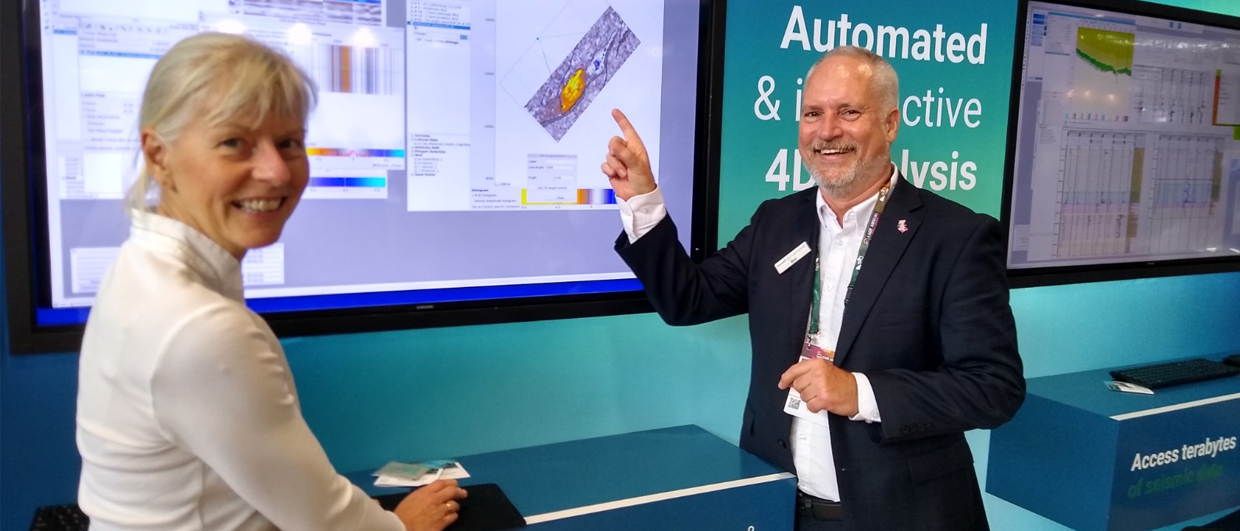“I had the luck of seeing how the sausage was made”, says Bill Shea at the start of our conversation, “and it made me feel uncomfortable.” Bill is the CEO and founder of the Norwegian geophysical processing and interpretation company Sharp Reflections. He refers to the way seismic data was processed and made ready for interpreters to get stuck into. “Seeing the assumptions that were made during the process, with the final stacked result being labeled as data with a capital D convinced me that a bridge was needed between what seismic processors do and seismic interpreters see.”
It was the seed that Bill needed to set up a company facilitating this very concept. And the timing was right.
“We entered the market when the wave of Multi-Client seismic surveys was taking off”, tells Bill. This was around 2010. “The opportunity for communication between seismic processors and interpreters is limited with Multi-Client surveys, and that model only created more of a need for software along the lines of what we now do.”
Secondly, around the same time, many smaller Norwegian oil and gas companies popped up that did not have the big tech facilities the bigger players used to have. “These companies were never going to license full-blown processing software because of budget and time constraints and would therefore benefit from a quick, fit-for-purpose solution.”
I had the luck of seeing how the sausage was made
These two factors combined had therefore created the niche that Bill identified through working in the industry as a seismic interpreter himself. And there was another reason why he wanted to get on with it.
The highest value
“The highest-value output of any new survey is the pre-stack data”, says Bill. “Yet, until today, interpreters often lack the ability to interrogate these data sets because they are too large to handle for desktop machines. At the same time, every interpreter knows that an amplitude-driven prospect is more likely to be drilled, which creates a strong case for having access to the pre-stack data to further proof that.”
“I met scientists from the Fraunhofer Institute in Germany who were working on the visualization of big datasets from the automotive industry”, explains Bill. Comparing the sizes of the datasets they were working with to what I was having access to made us conclude that there was scope to do it, provided that we could use the computing power of a cluster of machines rather than single desktops.”
Getting to work
Bill and his small team got to work. “It all comes down to speed”, he says. Using the technology we developed with Fraunhofer, through linking computing power, we could see how individual steps in the processing workflow affected the stacked reservoir image with just a few clicks of the mouse button. The inertia of the process had disappeared!”
Given the operator and seismic data landscape as described above, it is no surprise that Sharp Reflections really took off in Norway. “In 2015, we had 20 to 25 Norwegian oil companies using the software”, Bill says.
A seismic factory
Sharp Reflections did not only evolve around speed. Bill saw the need to challenge the classic processing workflows too.
“People in the processing industry are taught not to touch the primary energy and only apply a soft touch. But that leaves a lot of noise that gets in the interpreter’s way”, adds Bill. “With our software, we could, for example, remove multiples that survived the standard processing workflow.”
Another thing we were able to do is analyse the gathers directly. All of the AVO and seismic inversion workflows assume that the gathers are perfectly flat, i.e. the velocities are 100% correct. But in reality, we found that it is easy for 1-2% deviations to creep in, leading to interpreters making the wrong assumptions about the quality of the data. Taking that level of precision on yourself is a solution that we provide.
Our clients appreciated that level of scrutiny, which enabled them to say to the seismic companies: “Give us the migrated data and we do the last mile ourselves.”
That created a so-called seismic factory, with people taking the seismic data in, fixing the pre-stack gathers to subsequently send the data to a seismic interpretation platform. That was the first few years of Sharp Reflections.
“But how many software licences are you going to sell this way?”, Bill asked rhetorically. “Maybe you sell one licence to every oil company.”
A win-win
“An important next step in the development of our software came about when Statoil (now Equinor) came round and made us a good offer”, Bill continues. “They wanted to increase capabilities in the geophysical inversion domain, which the software they used at the time did not cater for. However, instead of asking us to develop all this ourselves, they offered code that had been developed already internally but had never been further embedded in software.”
The collaboration started in 2017 and continues until today. It is a really good example of how companies can work together and benefit from what both are good at.
“And don’t get me wrong, we don’t have exclusivity rights to use this Equinor code; any commercial party can use it, for a price”, adds Bill.
The same happened to getting a foot in the door in the onshore seismic world in the US. “We knew that if you want to do inversion of land seismic data, you really have to look at the pre-stack data because the quality of the data is often at the margins of what can be achieved”, Bill explains. Customers in the unconventional space told us: “If you are willing to invest in this, we know there is a market for your product.”
The Sharp Reflections team subsequently developed a tool to work with full-azimuth pre-stack land data. “And guess what, there is a market for it”, laughs Bill.
Clients are smart and they do things with your software that you didn’t anticipate and you’d better listen to what they say!
A brilliant observation
Sharp Reflection’s 4D capability, a feature that is key to the software’s development today, came about through a brilliant observation from the team of the Equinor Research Group. “One of them said; if you cheat and hack the full azimuth data model you can be much more efficient in the way you handle 4D data collections. It’s because you guys have the capability to include all the monitoring surveys into one volume; the software thinks it is azimuthal data but in fact it is time lapse data.”
“Clients are smart and they do things with your software that you didn’t anticipate and you’d better listen to what they say!”, reiterates Bill.
“So, the way we handle 4D was a 100% Equinor idea at the start”, Bill explains. “At the same time, we have always been clear that the investment required from our side to make the software work should enable us to use the final product in sales to other customers too. It needs honest conversations, but we have never run into issues this way. There is always a deal to be done.”
The company has contracts with almost all majors now. “This 4D focus was a real catalyst. It is because our timelapse solution enables them to see interactively the 4D response at the reservoirs without the need to calculate the difference between each survey specifically. And the full-azimuth solution we built for onshore data now also provides for working with OBN data”, adds Bill.
The challenge of maintaining control
Could Bill ever foresee being where he is now? “After working in oil companies for 12 years, I concluded that I’m not the person to always seek internal agreement and consensus on everything that was needed to move forward”, he says when I ask him about his learnings over the past decades. “Leading a start-up requires a very different approach, which suited me a lot better. However, now we are almost 50 people, the challenge in recent years has been to let go of some control. With the good people we have and continue to hire, I am confident that we can build this company further!”



